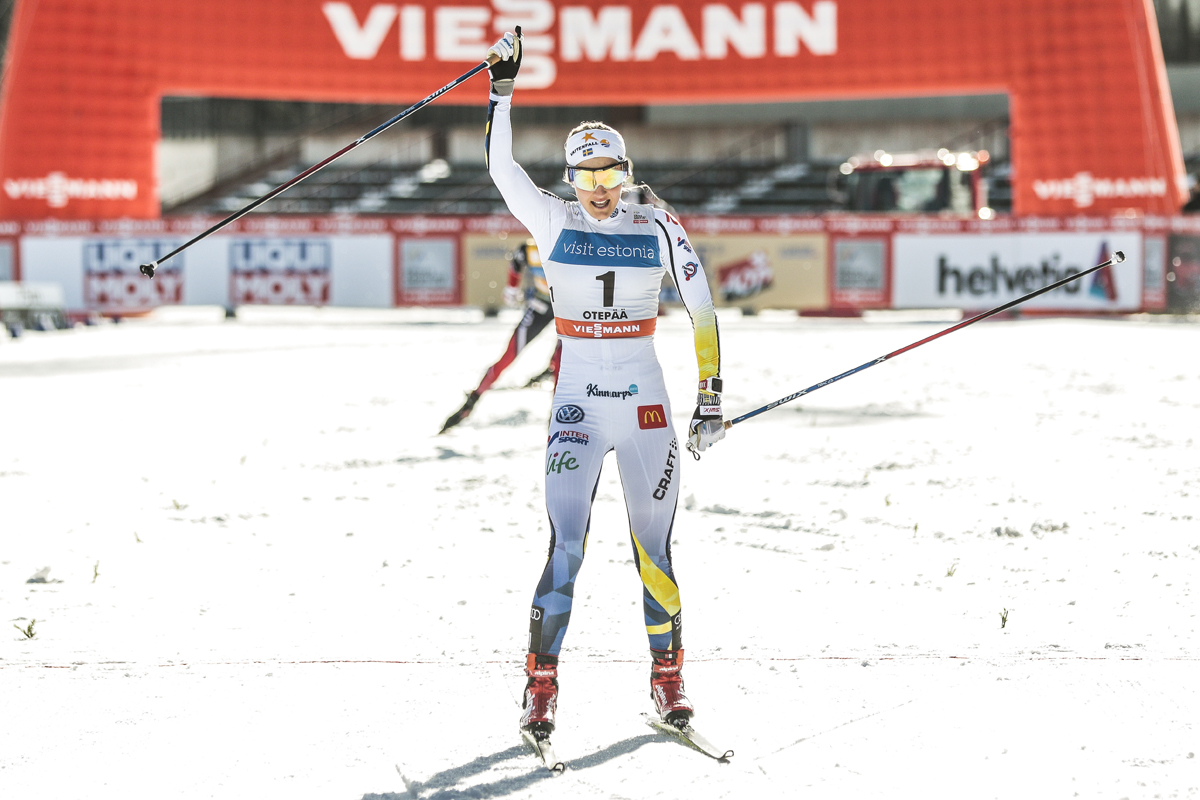
At 23, Sweden’s Stina Nilsson has nailed a business-like approach to World Cup starts. Standing 5-foot-9, she appears to tower over most of her competitors, and before her signature races (sprints) she appears deep in contemplation, definitely in the zone. During those races, she’s usually the one setting the pace, and afterward, she’s almost always celebrating at the finish.
So far this season, Nilsson has won seven World Cup races — including today’s freestyle sprint in Otepää, Estonia. Four of those were sprints, three of them skate sprints. She also established herself as an all-around threat at last month’s Tour de Ski, winning the 10-kilometer skiathlon, 10 k freestyle pursuit and 10 k classic mass start — nearly half of the stages.
And on Saturday at the pre-World Championships World Cup in Otepää, Nilsson proved she’ll be tough to stop in her quest for World Championships gold next week in Lahti, Finland. She previously racked up three silver medals at 2015 World Championships at home in Falun, Sweden. Two of those were in team events, one was in the classic sprint.
This year’s World Championships begin in earnest on Thursday, Feb. 23, with a freestyle sprint. And considering Nilsson has won the last three World Cup skate sprints she’s competed in (and has a career total of six skate-sprint wins, putting her ahead of Norway’s Maiken Caspersen Falla with five), she couldn’t be more of a favorite.
It didn’t come easy on Saturday, with temperatures in the mid-30’s Fahrenheit on a brand-new sprint course in Otepää.
“Every year we go to Estonia we joke about what the course will look like,” U.S. Ski Team Women’s Coach Matt Whitcomb said on the phone Saturday. “It’s actually not making fun of them, it’s admiring how they are trying to adapt their terrain to the direction to sprinting has gone.”
The men’s 1.6 k and women’s 1.3 k courses are harder, he explained, “and what they are trying to do is have something that will stand up to a classic sprint, even though today was skating with world champs coming up.”
Pair that with increasingly mushy snow, and you have a day where the finals came down to a slog-fest.
“There was no glide in the final in that [last] hill,” American Jessie Diggins, the lone North American to reach the final on Saturday, explained on the phone after. “It was like Alpe Cermis for me.” (Alpe Cermis is the final climb of the Tour de Ski.)
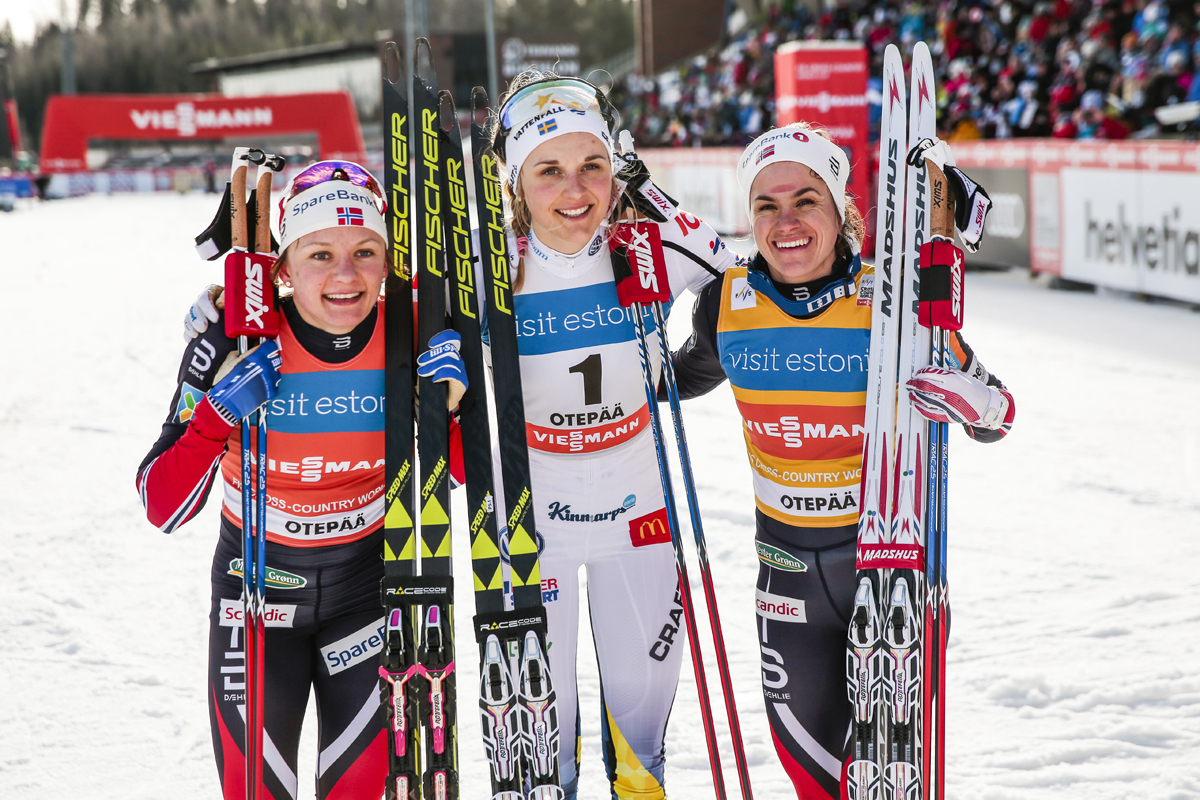
Nilsson, who had put herself in a position at the front or very close to it to win her quarterfinal, semifinal and ultimately the final, even said it was hard.
“There were difficult snow conditions on the track and it was hard to beat Falla,” she said, according to an Otepää press release.
In just about every World Cup sprint this season, Falla has been the other woman to beat. And in the last four skate sprints, including today, she’s been second. Before that, Falla won a skate sprint in Davos, Switzerland, where Nilsson missed qualifying in an uncharacteristic 31st. And in the two classic sprints at the start of the season, Falla finished second (behind Nilsson in the first race and her Norwegian teammate Heidi Weng in the other).
Notably, the 5-foot-3 Falla has placed in the top two in 11 out of the last 12 World Cup skate sprints she’s contested. With seven individual podiums this season and all but one putting her on the second step, you can imagine how hungry Falla — the 2014 Olympic freestyle sprint gold medalist — is for another win.
She won her quarterfinal on Saturday and placed second in her semifinal, 0.42 seconds behind Nilsson, before chasing Nilsson once again in the final. The two broke away on the final downhill, and Falla tried to make a move on the last tight corner to get around the Swede, but alas — another second place. Nilsson racked up her 10th individual World Cup victory in 2:49.96 minutes, and Falla was 0.27 seconds shy in second.
“In the final I did not have as good start as I hoped,” Falla said, according to a FIS press release. “It was difficult to find a good position. On the last climb I could follow Stina. Today’s second place is a good sign that my shape is getting better.”
Four U.S. Women Qualify in Top 12
Nilsson started the day by qualifying in first on Otepää’s one-lap sprint course, 0.6 seconds ahead of Norway’s Weng in second and 2.55 seconds ahead of American Kikkan Randall in third. Four U.S. women qualified in the top 12, with Sophie Caldwell in fourth (+2.6), Ida Sargent 10th (+3.47) and Diggins 12th (+ 3.93). Falla qualified seventh (+3.21).

Wearing bib 1, Nilsson went on to win her quarterfinal by 0.62 seconds over Caldwell before doing more of the same in the first semifinal, where she beat Falla. Early in the first quarterfinal, Caldwell found herself in third behind Norway’s Kathrine Rolsted Harsem and Nilsson, which was exactly where she wanted to be.
“I didn’t want to be leading in my quarter, but I wanted a clean start and then to settle into the front/middle part of the pack,” Caldwell explained in an email. “I tried to stay calm and conserve energy where I could to be able to have a strong finish. I wanted to hang as tight as possible to the leaders up the steep hill and over the top because I knew the draft could come into play. I think I executed my quarter just how I wanted to and my legs felt good enough to have a strong final stretch and finish 2nd.”
Caldwell edged Harsem by 0.09 seconds in a photo finish for second, and both advanced to the semifinal when Harsem earned a lucky loser spot. Nilsson and Caldwell raced in the first semifinal, where Nilsson led into the first of the two major climbs. Once again skiing in the middle of the pack, Caldwell stumbled about halfway up and had to work to catch back up to the group.
“I think I poled between my legs or on my ski or something and took myself out,” Caldwell wrote. “I recovered pretty quickly and was able to close the gap over the top of the first hill.”
By the time they reached the second climb, Norway’s Astrid Uhrenholdt Jacobsen had moved into first. Nilsson followed her in second over the top while Falla hung close in third.
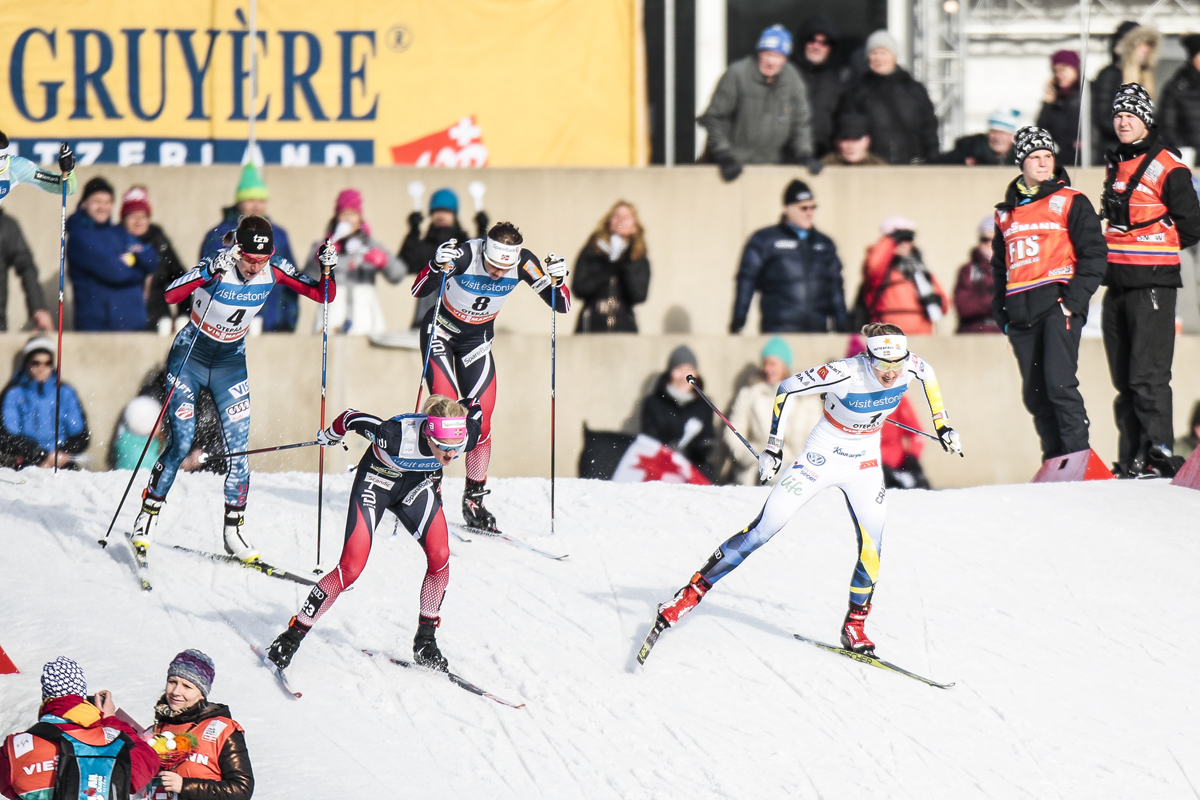
“Going up the second hill, the top three opened up a little gap and I was behind Ingvild [Flugstad Østberg of Norway] and we were unfortunately just far enough back so that we didn’t benefit a ton from the draft,” Caldwell explained. “There are a few things I would do differently if I were to do it again (namely not to fall), but I was really encouraged by my energy out there today.”
Caldwell finished fifth in that semifinal, 1.83 seconds behind Nilsson, who had reclaimed the lead at the bottom of the long downhill into the stadium. Falla automatically advanced to the final in second, and Jacobsen advanced as a lucky loser in third (+0.75). Østberg took fourth (+1.64), just ahead of Caldwell, and neither advanced to the final. That put Østberg in seventh and Caldwell 10th overall on the day.
Diggins Wins Quarter + Semifinal
Meanwhile, Diggins — the winner of her quarterfinal — won the second semifinal as well, beating out Weng by 1.21 seconds. Sweden’s Hanna Falk placed third (+2.52) behind Diggins, Sweden’s Ida Ingemarsdotter was fourth (+3.8), Randall fifth (+13.3) after a late crash, and Harsem sixth (+21.37) after face planting on the last downhill in a separate incident from Randall.
Diggins automatically advanced to the final along with Weng, and Falk made it as a lucky loser.
In the final, Nilsson again took charge out of the start, while Weng clung closely to her in second. Jacobsen once again took the lead, this time up the first climb, but Nilsson made her move back into first by the final steep uphill. Falla chased Nilsson over the top, followed by Weng, Jacobsen and Diggins — in that order — on the descent. Having dropped everyone else on the last hill, Nilsson and Falla raced toward the finish line as a unit. Nilsson stayed ahead, Falla took second, Weng third (+3.75), Jacobsen fourth (+4.91), Diggins fifth (+6.82), and Falk sixth (+21.73).
“I could not have done it any better, so I’m very happy,” Nilsson told the Otepää organizers. “The course was very good and I would like to come back and race here again.”
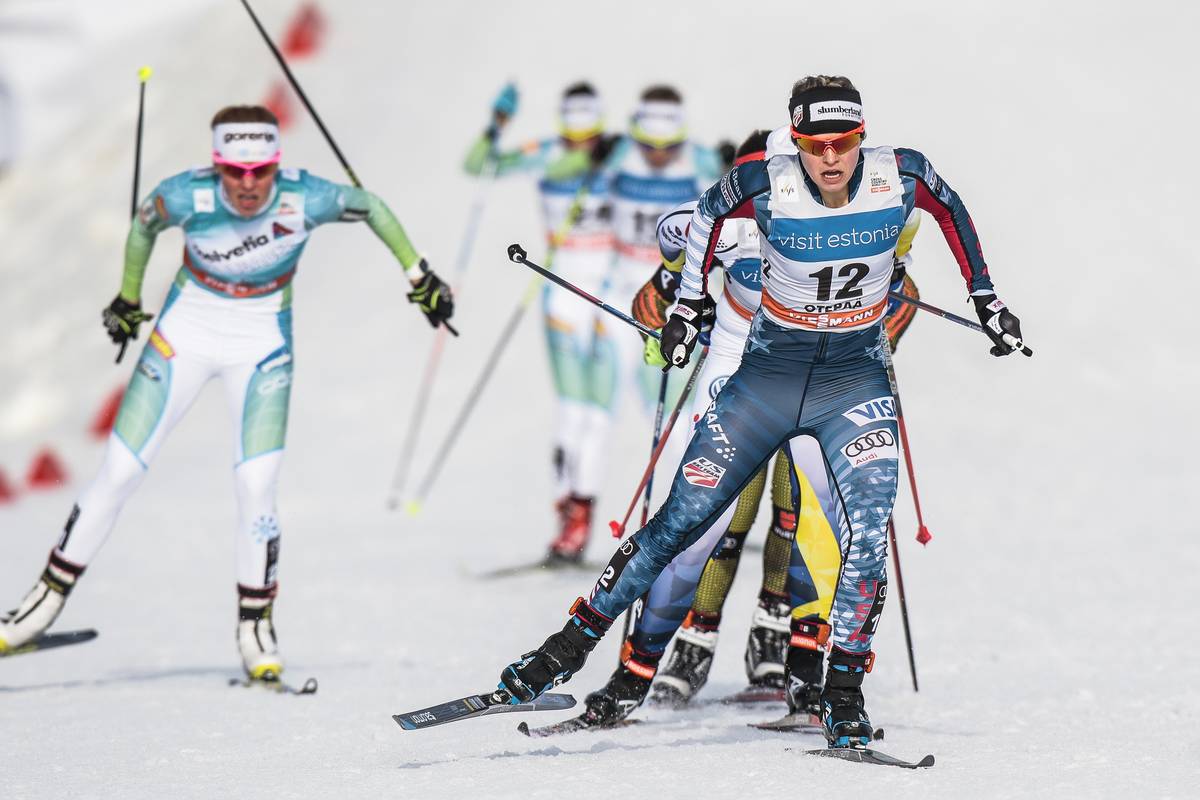
While Nilsson and Falla had tested their tactics against one another in the semifinal, Diggins didn’t meet either of them until the final. The 25-year-old American had previously won her quarterfinal by leading from start to finish, then her semifinal by capitalizing on a slingshot draft on the last downhill.
“In my quarter, I just wanted to stay out of trouble,” Diggins explained. “It’s a course where it’s hard to pass and with deep snow and icy spots, I saw a lot of potential for danger, so I wanted to stay way out anything that my happen. The best way to ensure that is to get way out in front. And it burns a lot of energy and I paid for it later in the final.”
She added that the biggest hill — the last, steep one that Diggins called the “headwall” — proved especially challenging because it required a different technique, namely jump skating.
In the semifinal, Diggins said she got stuck behind the wrong person on the way up that climband came out of it in fourth. Meanwhile, Randall had taken the lead by the top.
“I was actually proud of myself for mentally not counting myself out,” Diggins said. “Just saying, ‘OK, I’ll use the slingshot, downhill’s a big strength of mine, so I’m just going to get back in it.’ ”
That’s exactly what she did. Diggins shot wide around the last corner and surged into first, ahead of Randall, Weng, and Falk. Coming out of that corner and toward the finishing stretch, Randall lost her balance on the way up a small hill over a tunnel and fell out of contention.
“Right after Jessie passed me I was taking the inside line into the corner and then lost my balance on an ice patch and my weight went out the back,” Randall wrote in an email. “Thought I almost saved it for a split second and then my skis came out from under me. It was totally my fault but a real bummer. I was feeling strong and ready to be in the final.”
Meanwhile, Diggins gained some confidence with her semifinal win.
“It was a good moment for me realizing that I can execute good tactics. I don’t just have to put my head down,” she said.
In the final, Diggins wasn’t sure of the best move on the final uphill.
“I had this moment of hesitation at the bottom as to who do I follow? Do I follow her? It’s kind of like you are picking your security line at the airport, which line to I get in to go the fastest?” she said. “I think that moment of hesitation definitely cost me, but then when they went, it was really quick and I was not technically able to go. I was just like stepping as hard as I could, but I think I needed to be more like a hop skate in order to go. After that, I just worked on preserving my spot.”
After being gapped, she said it was tough mentally to finish the race in a solid position.
“I was just trying to work on pushing, I really need to practice for Lahti, so get in there,” she said.
Diggins said she has a “pretty ambitious race schedule” planned for Lahti World Championships, and while she couldn’t say which races she’ll do, she intended to sit out Sunday’s 10 k classic individual start to rest up for next week.
“To pull it off, I need to come into it quite rested,” Diggins, a 2013 freestyle team sprint champion and 2015 individual silver medalist, said of her World Championships goals.
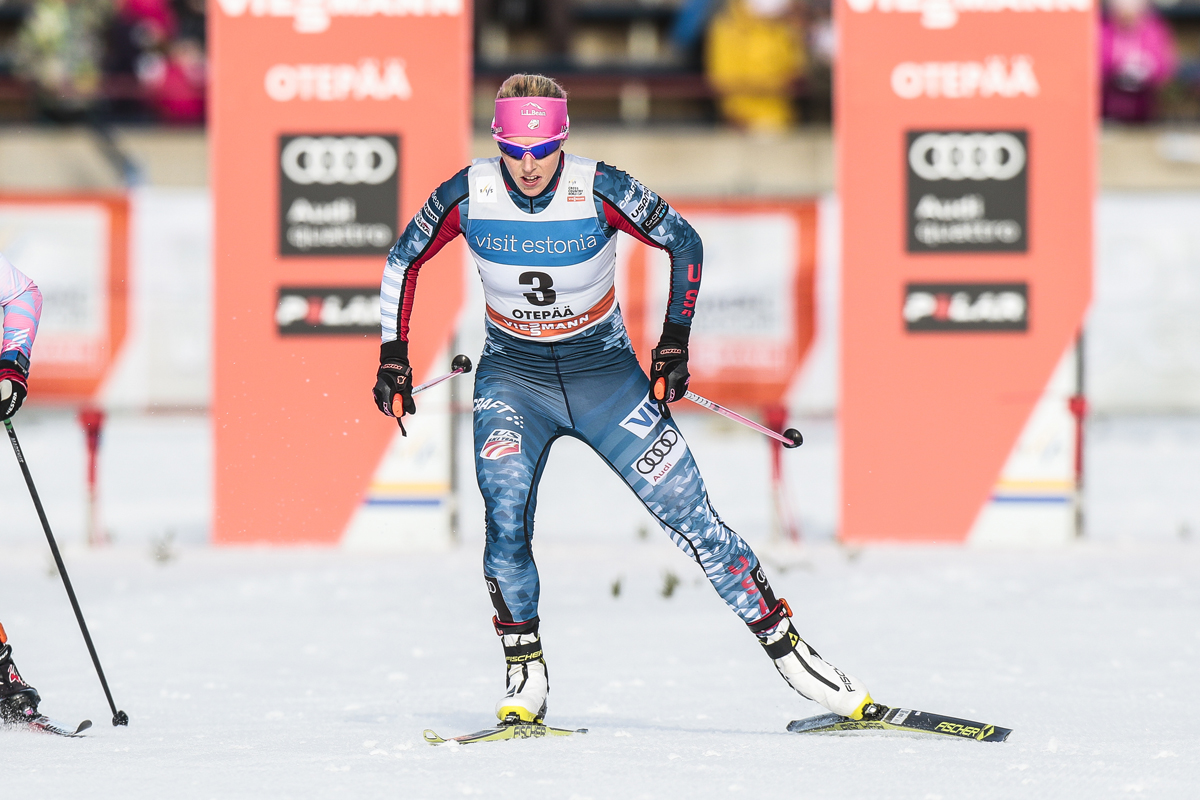
While Diggins ended up fifth overall and Caldwell 10th on Saturday, Randall had her second-best individual result of the season in ninth, and it all started with her being the third-fastest qualifier.
“That qualification would have beat some of her performances from when she was at the top of her game,” Whitcomb said. “I can’t help to wonder if she is back at the top of her game.”
“To be able to lay down a fast qualifier like that gives me confidence that I’ve made it one step closer to the kind of race form I had when I was contending for wins and podiums in every skate sprint,” Randall wrote.
In her quarterfinal, Randall initially finished third, 0.3 seconds behind Jacobsen, who won that heat. Russia’s Natalia Matveeva finished second, but was relegated to last (and 30th overall) for obstructing Randall. According to Randall, she experienced two instances of obstruction in that heat.
“Coming into the stadium I tried to make a move on the outside and Matveeva abruptly moved over in front of me as I came up alongside her,” she wrote. “So I reset and tried to set myself up on the final turn. But then she cut across me again and I lost all my momentum.”
Randall asked her coaches to file a protest. After reviewing the video, the jury deemed Matveeva’s first cut-off grounds for a penalty. Thus, Randall advanced to the semifinals in second place.
In her semifinal, Randall resolved to be more aggressive to ensure better positioning.
“Even after a not-so-great start again, I made a push to get up closer to the front,” she wrote. “I skied the downhill 180 corner pretty well and got my own lane up the steep climb and was able to make a move over the top. Jessie followed me and came flying out of my draft as we came toward the stadium.
“I was definitely bummed have missed out on the chance to test myself against the best in the final today but I am really encouraged with how I felt all day,’ she added. “I learned some good tactical lessons and I am really looking forward to another chance in a few days!”
Randall was listed to start Sunday’s 10 k classic.
Also listed for Sunday’s race are Sargent and Bjornsen (among other U.S. women), who placed 13th and 20th overall, respectively, on Saturday. After qualifying in 10th, Sargent looked poised to win her quarterfinal before she ultimately finished third (0.35 seconds behind Falla) and did not advance.
“For the quarterfinal my strategy was to stay near the front and stay out of trouble and try to stay in contact going into the downhill,” Sargent wrote in an email, adding that she wanted to stick with Falla.
But feeling especially excited and strong, she decided to go for it and take the lead soon after the start. On the last climb, Falla attacked over the top and led into the downhill. Sargent followed, taking a few extra skate steps to rein Falla back in.
“Sometimes I don’t think I work the graduals enough so I made an effort to push a little longer going into the downhill and I think that gave me the power to pass Maiken on the downhill,” Sargent described. “I was proud of myself for holding my line and and skiing with confidence in the heat which is another thing that I’m working on But then unfortunately my legs were really flooded in the finish stretch and I lost the crucial time there. So I feel I’m really close but just need to keep working to have that extra couple tenths of a second.”
“10th in the qualifier is definitely one of my best if not my best qualifiers for a full World Cup field,” she acknowledged. “… We had insanely fast skis today so the techs did some magic work and that was a huge help making it such a great day for the team.”
In the same quarterfinal as Randall, Bjornsen finished fourth, 2.82 seconds behind Jacobsen. In an email, Bjornsen wrote that her qualifier was slower than usual, “I think due to searching for my sprint gears and seemingly making the wrong ski selection.
“I was looking forward to the heats, because I know my energy is feeling well, I just needed to find that speed,” she added. “I had a great start, and tried to stay light in those really deep snow conditions. As we rounded the far side of the course and headed back up the really steep climb there, I tripped over some snow, and really got bogged down. It was one of those ‘wall climbs’, and I seem to need some work on that particular grade. That is where I lost contact with the leaders, and then didn’t manage to find the steam to come back to them unfortunately.”
Bjornsen explained that Saturday’s race was her team’s qualifier for the World Championships sprint, “and I unfortunately wasn’t able to make it,” she wrote. “I haven’t quite found my groove that I know I am capable of with sprinting yet this year, but I keep looking forward to it every time I try, because I think it is a small adjustment that I am on a search for. On the other hand, I still feel really good about my energy and fitness right now, so I am looking forward to tomorrow with great excitement. An individual classic 10k is a great race for me, and I can’t wait to take on this challenging course!”
Canada’s Beatty 29th
Canada’s Dahria Beatty nabbed the last qualifying spot in 30th and went on to finish sixth in her quarterfinal, 9 seconds behind Weng (who won that heat) for 29th overall. Beatty last competed at U23 World Championships in Utah, where she recorded three top-20 results. In the two weeks since, the 22-year-old Canadian U25 Team member has been in Canmore, Davos, and Otepää since Thursday. After this weekend, Beatty will travel with the team to Lahti to compete at senior World Championships.
“The course was a really hard one, the snow was soft which made it even more challenging and the final climb is really steep,” she wrote of Saturday’s race. “I managed to survive the steep pitch in my qualification but in the heats it had softened a bunch and that’s where the pack really got away from me. Something else to add to the list of things to work on!
“I was really happy to be back in the top-30 my first race back in Europe,” Beatty added. “My legs have been feeling a bit heavy the past week with all the travel but this was a really solid place to start the next period of racing and I think my body will be feeling all ready to go by next Thursday. I am confident in my fitness right now and I am really looking forward to experiencing my first World Championships!”
Canada had two others in the women’s race, with Cendrine Browne placing 48th and Katherine Stewart-Jones 49th.
The U.S. had a total of seven women compete on Saturday, with Chelsea Holmes and Rosie Brennan finishing 58th and 60th, respectively. Of those seven, four qualified in the top 12 and five finished the day in the top 20.
“It is incredibly competitive out there…,” Whitcomb said. “I think it means that we have a team that is operating at peak form and is ready for the championships.”
Alex Kochon
Alex Kochon (alexkochon@gmail.com) is a former FasterSkier editor and roving reporter who never really lost touch with the nordic scene. A freelance writer, editor, and outdoor-loving mom of two, she lives in northeastern New York and enjoys adventuring in the Adirondacks. She shares her passion for sports and recreation as the co-founder of "Ride On! Mountain Bike Trail Guide" and a sales and content contributor at Curated.com. When she's not skiing or chasing her kids around, Alex assists authors as a production and marketing coordinator for iPub Global Connection.



